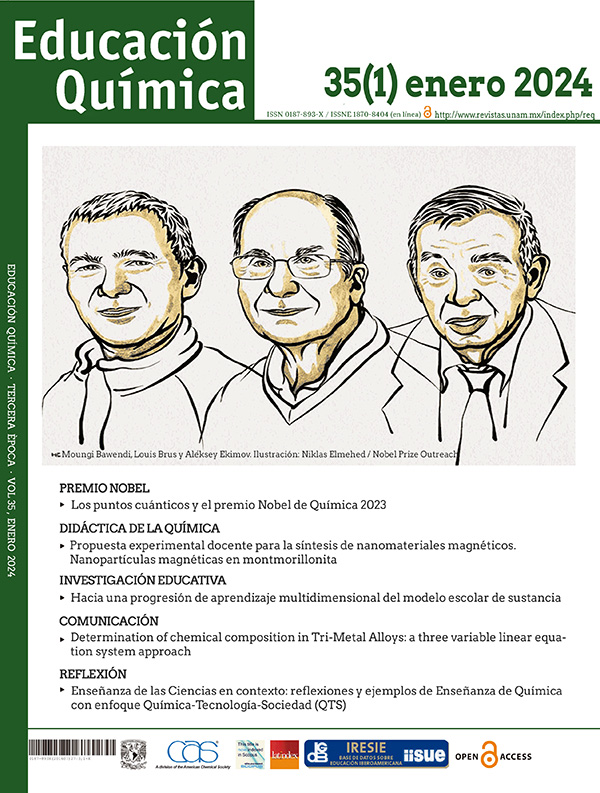Gamification to facilitate the learning of the nomenclature of metal oxides in high school students
Main Article Content
Abstract
The teaching-learning process of inorganic chemical nomenclature is complex and presents didactic limitations, which affect the meaningful learning of students. Consequently, the objective of this research was to evaluate the effectiveness of a didactic strategy based on gamification using Educaplay to improve the academic performance of high school students in learning the nomenclature of metal oxides. A systematic review of the literature, an explanatory approach and action research were carried out, with a mixed approach, a quasi-experimental design: a control group and an experimental group were created, with 38 first year high school students each, to whom a pretest and posttest were applied to measure the changes in their learning. SPSS V23 software was used to process the data collected. It was corroborated that the grades of the students belonging to the experimental group, once the didactic strategy was applied to them, were higher than the grades achieved by the students in the control group, who were taught inorganic nomenclature using the traditional methodology. It was concluded that the didactic strategy implemented improved the academic performance, motivation and attitude of the students towards their learning.
Article Details
Citas en Dimensions Service
References
Álvarez, M. V.; Figueroa Cepeda, H.; Pérez Alarcón, E. y Cedeño López, J. (2020). Estrategias lúdicas en el aprendizaje de la nomenclatura química inorgánica. Revista Cátedra, 3(1), 59-74. https://revistadigital.uce.edu.ec/index.php/CATEDRA/article/view/1966/3064
Bengochea, G. (2021). La gamificación: Una oportunidad para transformar las realidades. Revista Prefacio, 5(7), 69-85. https://revistas.unc.edu.ar/index.php/PREFACIO/article/download/35733/35851/126266
Bernate, J. y Vargas, J. (2020). Desafíos y tendencias del siglo xxi en la educación superior. Revista de Ciencias Sociales (Ve), XXVI (Número especial 2), 141-154. https://www.redalyc.org/journal/280/28064146010/28064146010.pdf
Callaguazo Álvarez, M. E., y Barba Maggi, M. A. (2017). Aplicación de la técnica informática Educaplay como estrategia para el aprendizaje de las biomoléculas en los estudiantes de bachillerato de la Unidad Educativa Andrés F. Córdova–Cañar, Ecuador. Revista Scientific, 2(6), 174-195. https://www.indteca.com/ojs/index.php/Revista_Scientific/article/view/144
Corchuelo Rodríguez, C. A. (2018). Gamificación en educación superior: Experiencia innovadora para motivar estudiantes y dinamizar contenidos en el aula. Edutec. Revista Electrónica de Tecnología Educativa, (63), 29-41 (380). https://www.edutec.es/revista/index.php/edutec-e/article/view/927
García Ruíz, R.; Bonilla del Rio, M. y Diego Mantecón, J. M. (2018). Gamificación en la escuela 2.0: Una alianza educativa entre juego y aprendizaje. Gamificación en Iberoamérica. Experiencias desde la comunicación y la educación, 323(4), 71-94. https://zenodo.org/record/1689029
Instituto Nacional de Evaluación Educativa (INEVAL). (2018). Educación en Ecuador. Resultados de PISA para el desarrollo. Ecuador: INEVAL. http://evaluaciones.evaluacion.gob.ec/BI/download/901/
Instituto Nacional de Evaluación Educativa (INEVAL). (2023). Informe final de resultados: Ser Estudiante Nivel Bachillerato, año lectivo 2021-2022. Ecuador: INEVAL. https://cloud.evaluacion.gob.ec/dagireportes/sestciclo21/nacional/2021-2022_3.pdf
Kalogiannakis, M.; Papadakis, S. y Zourmpakis, A. I. (2021). Gamification in science education. A systematic review of the literature. Education Sciencies, 11(1), 22. https://www.mdpi.com/2227-7102/11/1/22
Labrador, E. y Villegas, E. (2016). Unir gamificación y experiencia de usuario para mejorar la experiencia docente. RIED. Revista Iberoamericana de Educación a Distancia, 19(2), 125-142. https://www.redalyc.org/pdf/3314/331445859008.pdf
Manivel Chávez, R. A.; Ramos Rendón, M. y Sánchez Vázquez, R. (2021). Apps como herramientas digitales en la enseñanza de nomenclatura inorgánica. Educación química, 32(4), 180-190. http://dx.doi.org/10.22201/fq.18708404e.2021.5.80005
Melo Solarte, D. S. y Díaz, P. A. (2018). El aprendizaje afectivo y la gamificación en escenarios de educación virtual. Información Tecnológica, 29(3), 237-248. https://www.scielo.cl/pdf/infotec/v29n3/0718-0764-infotec-29-03-00237.pdf
Muñoz, J. (2020). Entorno Virtual de Aprendizaje Gamificado para el currículo ecuatoriano. Mamakuna, 14, 114-130. https://revistas.unae.edu.ec/index.php/mamakuna/article/view/357
Ortiz Colón, A. M.; Jordán, J. y Agredal, M. (2018). Gamificación en educación: Una panorámica sobre el estado en cuestión. Educação e Pesquisa, 44,1-17. https://www.scielo.br/j/ep/a/5JC89F5LfbgvtH5DJQQ9HZS
Pascuas Rengifo, Y. S.; Vargas Jara, E. O. y Muñoz Zapata, J. I. (2017). Experiencias motivacionales gamificadas: Una revisión sistemática de literatura. Innovus, Innovación Educativa (México, DF), 17(75), 63-80. https://www.scielo.org.mx/pdf/ie/v17n75/1665-2673-ie-17-75-63.pdf
Quintanal Pérez, F. (2016). Gamificación y la Física–Química de Secundaria. Opción. Education in the Knowledge Society, EKS, 17(3), 13-28. https://www.redalyc.org/pdf/5355/535554763002.pdf
Ramos Galarza, C. (2021). Diseños de investigación experimental. CienciAmérica, 10(1), 1-7. http://201.159.222.118/openjournal/index.php/uti/article/view/356/698
Rivera Vargas, P.; Neut, P.; Luccini, P.; Pascual, S. y Prunera, P. (2018). Pedagogías Emergentes en la la Sociedad Digital, Vol. 1, 1, 180. Albacete (España): LiberLibro. https://farodigital.org/wpcontent/uploads/2020/12/UTF8BUGVkYWdvZ2nMgWFzIGVtZXJnZW50ZXMgZW4gbGE-UTF8BIHNvY2llZGFkIGRpZ2l0YWwuIFZPTCAyLnBkZg.pdf
Sánchez Pacheco, C. L. (2019). Gamificación: Un nuevo enfoque para la educación ecuatoriana. Revista Tecnológica-Educativa Docentes 2.0, 7(2), 96–105. https://ojs.docentes20.com/index.php/revista-docentes20/article/view/16/31
Sánchez, C.; García, E. y Ajila, I. (2020). Enfoque pedagógico: la gamificación desde una perspectiva comparativas con las teorías del aprendizaje. 593 Digital Publisher CEIT, 5(4), 47-55. https://www.593dp.com/index.php/593_Digital_Publisher/article/view/202/470
Sanfélix García, F. (2020). Impacto Didáctico de Una Herramienta Educativa m-Learning Gamificada, en el Aprendizaje de la Química en la ESO. Obtenido de Dipòsit Digital de la Universitat de Barcelona: http://hdl.handle.net/2445/178810
Tajuelo, L. y Pinto, G. (2021). Un ejemplo de actividad de escape room sobre Física y Química en educación secundaria. Revista Eureka sobre Enseñanza y Divulgación de las Ciencias, 18(2), 2205. https://revistas.uca.es/index.php/eureka/article/view/6191/7428
Welbers, K.; Konijn, E. A.; Burgers, C.; de Vaate, A. B.; Eden, A. y Brugman, B. C. (2019). Gamification as a tool for engaging student learning: A field experiment with a gamified app. E-Learning and Digital Media, 16(2), 92–109. https://journals.sagepub.com/doi/full/10.1177/2042753018818342
Zepeda Hernández, S.; Abascal, R. y López, E. (2016). Integración de gamificación y aprendizaje activo en el aula. Ra Ximhai, 12(6), 315-325. https://www.redalyc.org/pdf/461/46148194022.pdf

Educación Química por Universidad Nacional Autónoma de México se distribuye bajo una Licencia Creative Commons Atribución-NoComercial-SinDerivar 4.0 Internacional.
Basada en una obra en http://www.revistas.unam.mx/index.php/req.




